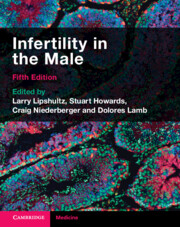Book contents
- Infertility in the Male
- Infertility in the Male
- Copyright page
- Contents
- Contributors
- Foreword
- Abbreviations
- Introduction
- Section 1 Scientific Foundations of Male Infertility
- Section 2 Clinical Evaluation of the Infertile Male
- Chapter 7 Infertility as a Metric of Men’s Health
- Chapter 8 Office Evaluation of the Subfertile Male
- Chapter 9 Evaluation of the Infertile Male’s Partner
- Chapter 10 Imaging the Male Reproductive System
- Chapter 11 Effects of Environmental Chemicals on Male Reproduction
- Chapter 12 Endocrine Causes of Male Infertility – Diagnosis and Treatment
- Chapter 13 Spermatogenesis – Diagnosis of Normal and Abnormal States
- Chapter 14 Inheritance and Male Fertility
- Chapter 15 The Varicocele – Approaches to Diagnosis and Management
- Chapter 16 Infection, Inflammation, and Immunological Causes of Male Infertility
- Section 3 Laboratory Diagnosis of Male Infertility
- Section 4 Treatment of Male Infertility
- Section 5 Health Care Systems and Culture
- Index
- References
Chapter 13 - Spermatogenesis – Diagnosis of Normal and Abnormal States
from Section 2 - Clinical Evaluation of the Infertile Male
Published online by Cambridge University Press: 08 July 2023
- Infertility in the Male
- Infertility in the Male
- Copyright page
- Contents
- Contributors
- Foreword
- Abbreviations
- Introduction
- Section 1 Scientific Foundations of Male Infertility
- Section 2 Clinical Evaluation of the Infertile Male
- Chapter 7 Infertility as a Metric of Men’s Health
- Chapter 8 Office Evaluation of the Subfertile Male
- Chapter 9 Evaluation of the Infertile Male’s Partner
- Chapter 10 Imaging the Male Reproductive System
- Chapter 11 Effects of Environmental Chemicals on Male Reproduction
- Chapter 12 Endocrine Causes of Male Infertility – Diagnosis and Treatment
- Chapter 13 Spermatogenesis – Diagnosis of Normal and Abnormal States
- Chapter 14 Inheritance and Male Fertility
- Chapter 15 The Varicocele – Approaches to Diagnosis and Management
- Chapter 16 Infection, Inflammation, and Immunological Causes of Male Infertility
- Section 3 Laboratory Diagnosis of Male Infertility
- Section 4 Treatment of Male Infertility
- Section 5 Health Care Systems and Culture
- Index
- References
Summary
While we have no way to know exactly, Homo sapiens have probably had fertility problems for many thousands of years, though the causes ascribed to infertility have changed, as have the treatments. What has certainly changed over the millennia are the causes of male infertility and our understanding of these etiologies and, of course, the treatments for male infertility.
- Type
- Chapter
- Information
- Infertility in the Male , pp. 218 - 236Publisher: Cambridge University PressPrint publication year: 2023



